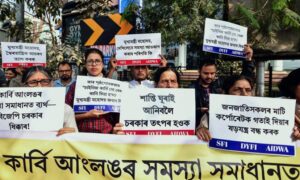
File Picture Courtesy : India Travel Forum ( representational image)
There has been no Alexis de Tocqueville to write on democracy in India though it has been a remarkably functioning democracy and presently ranked 42 in the category of ” flawed democracies” in current year’s Democracy Index of the intelligence unit of the Economist magazine.
However it may be useful to look at the North East from a perspective of how democracy is functioning there as the Constitution and the state laws have together put in place 7 states and 22 administrative units as ” autonomous councils”. These Councils are entrusted with governance of a number of subjects and implementation of schemes which in the normal course should the responsibility of the states or the Panchayati Raj institutions elsewhere in the country.
Their functions continue to overlap and institutions create separate power centres raising the ambitions of the political class: and by relegating the state facilitate growth of separatist tendencies and demand for statehood. Strangely, the policy makers tend to ignore this aspect as evident from the readiness with which demands for new autonomous councils and even states in the extended North East are tacitly encouraged and even well received. This unique feature of governance of the North East Region merits a review from a geostrategic perspective which is attempted here.
North East has been a veritable laboratory of political experiments ever since the Ahom kingdom came under the control of the British East India Company in 1826 under the terms of the Treaty of Yandaboo following the defeat of the Burmese King in the first Anglo Burmese war. A number of Laws like the Scheduled Districts Act 1873, Bengal Eastern Frontier Regulation Act 1873 and much later instruments like the ” excluded” and ” partially excluded” areas under the Government of India Act 1935 were enforced to ensure separate Administrative arrangements for the Hill Areas.
If one looks at the abortive “Coupland Plan” in 1947 of the British to create a ” Crown colony ” comprising the Hill areas of the North East to be carved out of British India there is reason to hold that the British had kept the option of separating atleast some Hill areas from India ever since the creation of Assam; and much like the way Burma was made a part of India and then separated in 1937.The Inner Line Permit system under the aforementioned Bengal Regulation 1873 was designed to provide strategic space for such a move in the future.
After independence in 1948, “Tribal belts and blocks” were created in Assam in areas inhabited by the Scheduled Tribes (Plains) under the Assam Land Revenue Regulation 1886.The Sixth Schedule of the Constitution – a mini Constitution for the “Hill areas of Assam had an uneasy start because the notifications of the Governor of Assam under Sec 1(g) of the schedule defining the jurisdiction of the autonomous district councils in the Naga Hills district of Assam in Part A of the schedule and the areas under Part B which constitute Arunachal Pradesh today including the Naga tribal area were never issued; and therefore the Sixth Schedule was not extended to these areas. After creation of the state of Nagaland in 1963 and grant of statehood to Arunachal Pradesh , these these tribal areas were deleted from the Sixth Schedule.
It is clear from the Boordoloi committee’s report which resulted in the Sixth Schedule and debates in the Constituent Assembly that it was never the intention of the founding fathers of the Constitution to extend the Sixth Schedule to any other part of the country and even in the plains Tribes inhabited areas of Assam as the schedule was Assam hill aeas specific and did not apply to Tripura and Manipur.
This led to a view that possibly a major object of the Sixth Schedule was to preserve the integrity of Assam. However, a departure from this rigid position was made when the Sixth Schedule was extended to Tripura tribal areas district following the Tripura Accord dated 12.08.1988 and the Constitution (Amendment)Act 1988.
This created a precedent and again following Bodo Accord dated 10 Feb 2003 provisions of the Sixth Schedule were extended to Bodoland Territorial Council areas under the Sixth Schedule under the Constitution Amendment Act 2003. It may be noted that the Bodos are Plains and not Hill Tribes of Assam and the areas inhabited by Plains Tribes were not put either in the Excluded or the Partially Excluded Areas under the Government of India Act 1935.
However, “Tribal belts and blocks” of land were notified under chapter 10 of the Assam Land Revenue Regulation1886 in 1948 to protect tribal lands from alienation. The Sixth Schedule has not been extended to any other part of the North East Region after the Bodo Accord in 2003.
This backdrop needs appreciation as it shaped the aspirations of the ethnic groups and political objects as the Sixth Schedule is considered as the bench mark and a kind of minimum object which could be later improved upon ; and this approach resulted in the grant of substatehood to Meghalaya in 1969 within the state of Assam which turned out to be temporary and not really a workable arrangement. Ironically the continuation of the autonomous district councils in Meghalaya and Mizoram even after attainment of full statehood kept the concept alive in identity politics possibly because the word ” autonomy” occurs in the Constitution only in respect of the institutions under the Sixth Schedule.
The author recalls the views of Shri B. Siva Raman I.C.S. former Cabinet Secretary who in his capacity as a member of the Centre State Relations commission headed by Justice Sarkaria stated during his visit to Shillong in 1986 that for this very reason” the Sixth Schedule is a dangerous provision of the Constitution”. Its subsequent extension to Tripura and Bodoland in Assam shows that the Central government still consider it as an option or a model for replication contrary to the intention of the makers of the Constitution. In the North East, Assam and Manipur took the Sixth Schedule as a framework and with some changes succeeded in putting in place ” autonomous councils” to satisfy the identity assertion of certain ethnic groups.
Thus, six autonomous Tribal councils have emerged in Assam as stated below:
1. Tiwa tribal Council, Mori gaon .
2.Rabha autonomous Council, Goalpara.
3.Deori autonomous Council, Lakhimpur
4.Mishing tribal Council, Dhemaji
5. Thenga kachari , Titabar
6.Sonwal Kachari , Dibrugarh.
These councils have been set up under the state laws and funded mainly from the state budget to take up development activities in subjects allotted and the central government at times sanctioned grants to the councils for implementation of schemes.However, the Councils do not have any power to make laws and are a kind of Tribal area specific local self governing institution.
The 6 autonomous district Councils in the hill areas of Manipur were constitued under altogether different circumstances. In 1971 during the process of grant of state hood and when Manipur was still an union Territory, the government of India enacted the Manipur Hill Areas District Councils Act 1971 – an act of the Parliament to safeguard the interests of the hill Tribes of Manipur by creating 6 autonomous district Councils which also meant creation of 6 districts. This Act is a mix of the provisions of the 5th and the sixth Schedules of the Constitution though the councils do not enjoy the powers to make laws but empowered to deal with subjects specified under the Act.
Later Manipur Hill areas District Councils Rules were made by the Manipur Assembly under the Act by which the district Councils are to be governed; and for this purpose Article 371 (c) of the Constitution was amended (27th constitutional amendment) which provided Constitution of a committee of MLA’s elected from the hill areas to ensure proper functioning of the councils.
However this reform was a non starter due to trust deficit between the Tribal people and the Imphal valley based Meitei leadership and the hill Tribes demand for extension of the 6th schedule made the issue complicated and stalled elections for 21years.
Though elections were held in 2010 and the councils formed, the misunderstanding continued and the councils complain that no real powers or funds have been devolved and that they are more like bodies subordinate to the district administration like the District Rural Development Agency. Moreover, 26 subjects which under the 2008 amendment to the aforementioned Act were to be transferred to the district Councils have not been transferred nor budget provisions enhanced.
The 1971 Act also ensures that the Panchayati Raj institutions under the 73rd amendment to the Constitution cannot be extended to Manipur. Thus the local self Government institutions could not be established in the hills which deepened the plains- hills divide in Manipur; because in the valley the fact that the hill Region comprises 90% of the geographical area and the extension of the 6th Schedule means a step to separate statehood there has been fierce opposition to the idea.
If we consider the fact that as of now there are 3 autonomous district Councils in Assam and 3 each in Meghalaya and Mizoram and one in Tripura under the sixth Schedule and 6 plus 6 twelve councils in Assam and Manipur as detailed above, the North East region emerges as the most fractured Region in India with seven states (Sikkim is not included in this exercise for its very different history) , 10 sixth Schedule dist councils and 12 autonomous councils- 29 administrative units in all having varied ” representative” character covering a population of about 45 million; and that too in a border region connected with the rest of the country through a 27km “Siliguri land Corridor”. From the geo strategic perspective this arrangement of diffused governance is likely to make it susceptible to interference from across the border in covert or overt forms. And, evidently proliferation of democratic institutions did neither unite the diverse ethnic groups nor fulfill their aspirations: rather it fuelled aspirations of other groups for such dispensation and hence the unending” identity assertion” in the North East and violent movements.
In this situation and keeping in mind the Act East Policy a holistic study of how the states and other autonomous bodies are functioning seems timely as no coherent synergy to integrate the North East region to the ASEAN economy could be developed without improvement in governance in all ” sub systems “and to consider putting an end to political recognition of “territoriality of identity” in the Region.
The fact that no such study has been done (and even the Vision 2020 document of the North Eastern Council didn’t address this issue) perhaps explains why the North East is seen always drifting. It is time to stop this trend.
( The writer is a retired IAS officer of the Assam – Meghalaya cadre and has served as Scientific Consultant in the office of the Principal Scientific Advisor to the Government of India)


















